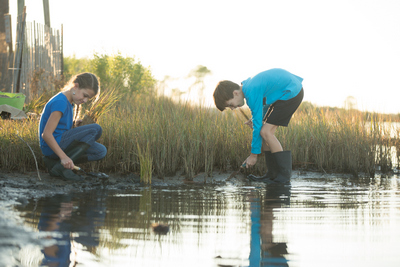The yellow school busses pull into the parking lot at Charles E. Cessna Landing in Walton County. Brakes hiss and doors squeal open and the excited chatter of children goes from muted to a dull roar. Third grade students from Butler Elementary School leap to the ground, making a bee-line toward their teachers, who herd them together to receive their instructions. All year they have raised smooth cordgrass plants in their school nursery; now, these 200 students will have a chance to build their very own living shoreline.
A living shoreline is a green alternative to shoreline hardening, like sea walls and rip rap. Reef breakwaters slow wave energy and subsequent erosion, while planting native shoreline grasses provides more habitat while holding the sediment in place.
The Butler students are part of a dual-county Grasses in Classes education program, run by the Choctawhatchee Basin Alliance (CBA). CBA’s Grasses in Classes is a hands-on, environmental education program that gives students a direct role in the restoration of Choctawhatchee Bay. In partnership with AmeriCorps and with partial funding from the USFWS Coastal Program and National Fish & Wildlife Foundation, CBA provides teachers in Okaloosa and Walton Counties the equipment and materials required to grow shoreline grasses at their respective schools.
Grasses in Classes students tend salt marsh nurseries throughout the school year, and receive monthly education on local estuarine topics that meet Florida’s state science standards from CBA and AmeriCorps members. At the beginning of the year, the schoolchildren split the grasses to increase the nursery stock. The Cessna Landing field trip is the culmination of all they’ve accomplished.
Butler Elementary Grasses in Classes students work in teams to place three plants and sand into a biodegradable burlap bag, which is then placed along an eroded portion of the shoreline. In addition to planting, students seine and net native species, practicing fish and crustacean identification before releasing the little critters with gentle hands. They learn about marine debris, play a game based on water salinity, as well as complete an activity designed to teach students about ecological adaptation.
“The students have waited all year to plant their grasses here,” says Amanda Briant, Education Coordinator for CBA, “They become a critical part of an important coastal process, and many students continue to ‘visit’ the areas that they restore.”
She continues, “We know their experience inspires a greater appreciation of their local waters and helps them develop into future coastal stewards.”
In addition to Grasses in Classes, some Walton County middle-schools also work with CBA to incorporate Dunes in Schools into their monthly lesson plans. Expanding on the knowledge garnered from Grasses in Classes, Dunes in Schools students raise sea oats for restoration initiatives along the Gulf of Mexico and coastal dune lakes.
“We want students to experience field trips and real-world restoration projects three times across their K-12 education,” Alison McDowell, CBA Director, explains. “In the future we hope to expand our high school initiative – Spat On! – to Walton County schools as well.”
In addition to grants, local businesses – like Cox Communications and Okaloosa Gas – sponsor these year-long lessons in local schools. For more information on how to sponsor a classroom, email cba@nwfsc.edu or go to basinalliance.org.
The post CBA Brings “Grasses in Classes” program to Butler Elementary appeared first on South Walton Life | 30A News, Events and Community Information.



Be the first to comment on "CBA Brings “Grasses in Classes” program to Butler Elementary"